Top Iranian Dishes You Must Try
Iranian dishes are among the most diverse and delicious in the world, with a long history and a wide range of influences. Iranian cuisine is based on the use of fresh ingredients, such as herbs, fruits, vegetables, nuts, dairy products and meat, that are cooked with skill and creativity. Iranian dishes are often flavored with spices, such as saffron, turmeric, cinnamon, cardamom and cumin, that add color and aroma to the food. Iranian dishes are also known for their use of sour elements, such as lemon juice, vinegar, pomegranate molasses and dried limes, that balance the sweetness and richness of the dishes. Iranian dishes can be categorized into different types, such as rice dishes, stews, kebabs, soups, salads, breads, pastries and desserts. Rice dishes are the staple of Iranian cuisine, and they are usually served with a variety of accompaniments, such as meat, fish, poultry, vegetables or legumes. Stews are another common type of Iranian dishes, and they are cooked with different ingredients and sauces that give them distinct flavors and textures. Kebabs are the most famous type of Iranian dishes outside Iran, and they are made with various kinds of meat or fish that are marinated and grilled on skewers. Soups are also an important part of Iranian cuisine, and they are often thick and hearty with noodles, beans or grains. Salads are usually fresh and light with herbs, vegetables and cheese. Breads are baked in different shapes and sizes and eaten with cheese, butter or jam. Pastries are sweet or savory and filled with nuts, dates or cheese. Desserts are usually rich and sweet with honey, rose water or saffron. Iranian dishes are a reflection of the country’s culture and geography, and they offer a taste of its history and diversity.
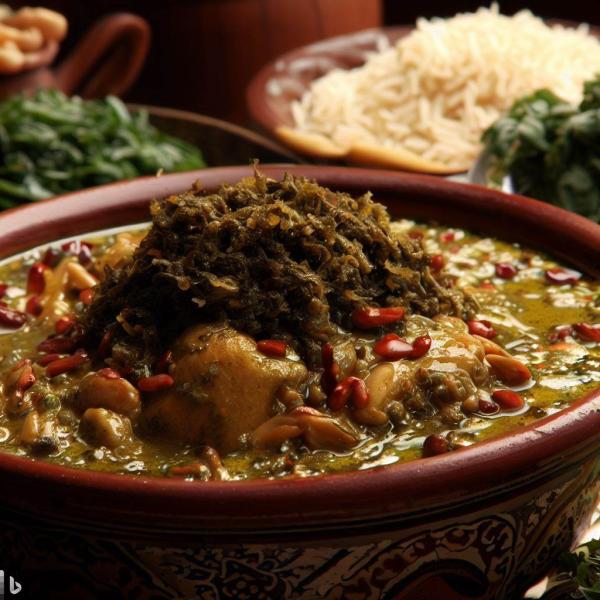
ranian cuisine is rich and diverse, with many dishes that reflect the country’s history, culture and geography. Some of the top Iranian dishes you should try are:
Ghormeh sabzi
A hearty stew of herbs, red kidney beans, dried limes and lamb or beef. It is considered the national dish of Iran and is often served with rice.
Ghorme Sabzi is a delicious and aromatic Iranian stew that has been cooked for centuries in different regions of the country. The name of the dish means “herb stew” in Persian, and it refers to the main ingredient of the dish: a mixture of fresh or dried herbs that are chopped and fried in oil. The herbs include parsley, cilantro, fenugreek, dill and sometimes spinach or chives. The herb mixture gives the stew a unique green color and a wonderful smell that fills the kitchen. The stew also contains red kidney beans that are soaked overnight and cooked with the herbs, dried limes that are pierced and added to the pot to provide a sour and citrusy taste, and lamb or beef that are cut into small pieces and browned before being simmered with the rest of the ingredients. The stew is seasoned with turmeric, salt, pepper and sometimes saffron. Ghorme Sabzi is usually cooked for several hours over low heat until the meat is tender and the sauce is thick and flavorful. It is traditionally served with steamed rice or bread and yogurt or torshi (pickled vegetables). Ghorme Sabzi is a hearty and satisfying dish that is rich in protein, fiber, iron and vitamin C. It is one of the most popular and beloved dishes in Iranian cuisine, and it is often prepared for special occasions, such as weddings, holidays and family reunions. Ghorme Sabzi is more than just a dish; it is a part of Iranian culture and identity that represents the diversity and beauty of the country’s land and people.
Kebab
The most famous Iranian food, with various types of meat (such as lamb, chicken, beef or fish) marinated and grilled on skewers. It is usually served with rice, bread, salad and yogurt sauce.
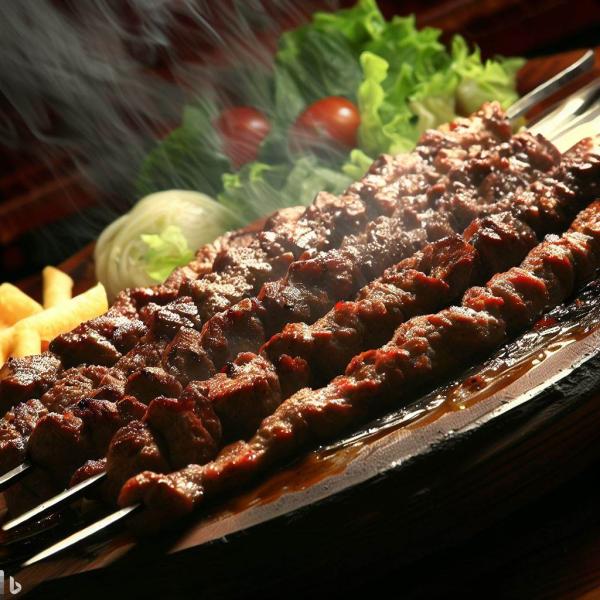
Kebab is a generic term for various types of grilled meat dishes that are popular in many parts of the world, especially in the Middle East, Central Asia, South Asia and the Mediterranean. The word kebab comes from the Persian word kabab, which means “to roast”. Kebab can be made with different kinds of meat, such as lamb, beef, chicken, fish or seafood, that are cut into small pieces and marinated with spices, herbs, yogurt or oil. The meat pieces are then threaded onto skewers and cooked over a fire or a grill. Kebab can also be made with ground meat that is shaped into balls or patties and grilled or fried. Kebab can be served with various accompaniments, such as rice, bread, salad, yogurt sauce, pickles or onions. Kebab has many regional variations and names, such as shish kebab, doner kebab, kofta kebab, tikka kebab, seekh kebab and shawarma. Kebab is a delicious and versatile dish that can be enjoyed as a main course or a snack. Kebab is also a social dish that brings people together around a fire or a table. Kebab is a symbol of the culinary heritage and diversity of the countries and cultures that have contributed to its evolution and popularity.
Dizi (Abgoosht)
A traditional dish of lamb, chickpeas, potatoes, tomatoes and onions cooked in a clay pot. It is eaten by mashing the ingredients with a wooden pestle and dipping bread into the broth.
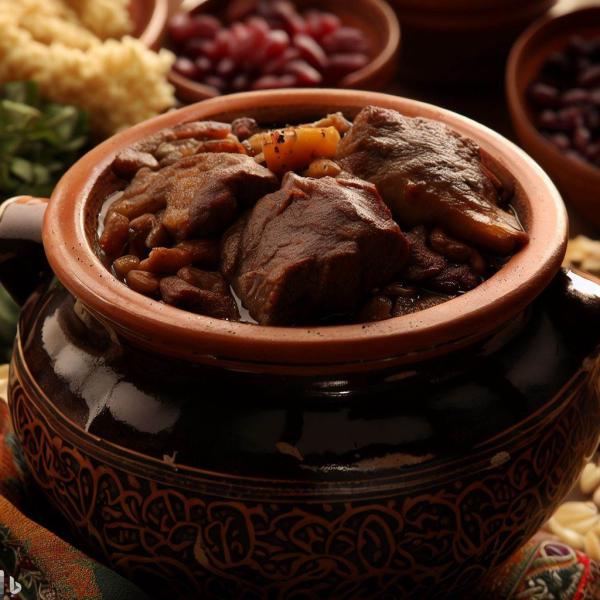
Dizi is a traditional Iranian dish that is also known as abgoosht, which means “meat broth”. Dizi is a hearty and rustic dish that consists of lamb, chickpeas, potatoes, tomatoes, onions and spices that are cooked together in a clay pot. The clay pot is called dizi or abgooshtboor, and it has a special shape and design that allows the steam to circulate inside and prevent the ingredients from burning. Dizi is usually cooked for several hours over low heat until the meat is tender and the broth is rich and flavorful. Dizi is eaten in a unique way that involves two steps. First, the broth is poured into a bowl and eaten with bread or spooned over bread. This part of the dish is called tilit or shorba. Second, the remaining ingredients are mashed with a wooden pestle and eaten with bread, pickles, fresh herbs and torshi (pickled vegetables). This part of the dish is called goosht or kalleh pacheh. Dizi is a filling and satisfying dish that is often served in traditional restaurants or teahouses. Dizi is also a social dish that is shared among friends and family. Dizi is a symbol of the simplicity and authenticity of Iranian cuisine and culture.
Tahchin
A savory rice cake layered with chicken, yogurt, eggs and saffron. It is baked until golden and crispy on the outside and soft and moist on the inside.
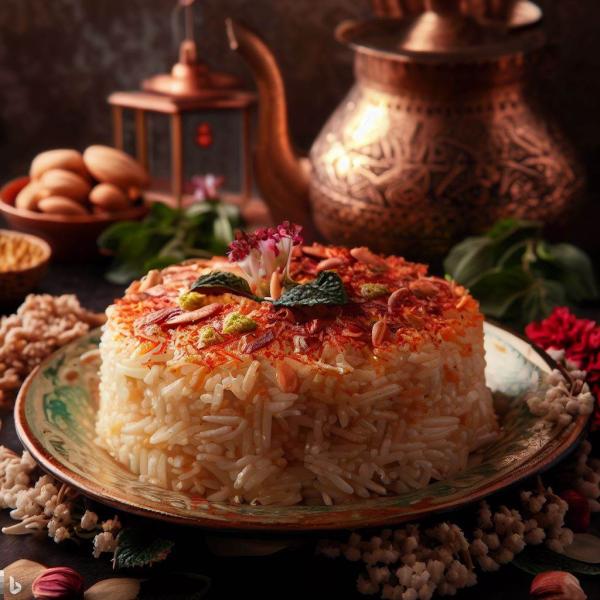
Tahchin is a savory rice cake that is one of the most elegant and delicious dishes in Iranian cuisine. The name of the dish means “arranged at the bottom” in Persian, and it refers to the way the rice is layered and cooked in a pot. Tahchin is made with rice that is parboiled and mixed with yogurt, eggs and saffron. The rice mixture is then spread on the bottom and sides of a pot that is greased with butter or oil. The rice forms a crust that is golden and crispy on the outside and soft and moist on the inside. The rice crust is filled with a layer of chicken, lamb or beef that is cooked separately with onions, garlic and spices. The meat layer can also be replaced or complemented with vegetables, such as spinach, eggplant or mushrooms. The pot is then covered and baked in the oven until the rice is fully cooked and the flavors are blended. Tahchin is usually inverted onto a large platter and cut into wedges like a cake. It is often garnished with barberries, pistachios, almonds or dried rose petals. Tahchin is a festive and impressive dish that is usually served for special occasions, such as weddings, birthdays and holidays. Tahchin is a symbol of the artistry and sophistication of Iranian cooking and culture.
Koofteh Tabrizi (Tabriz meatballs)
A large meatball stuffed with dried fruits, nuts, eggs and spices. It is cooked in a tomato sauce and served with bread or rice.
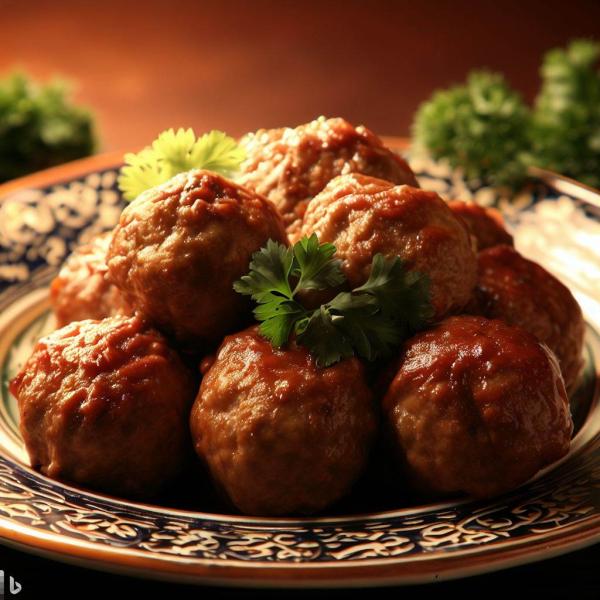
Koofteh Tabrizi is a traditional Iranian dish that originates from the city of Tabriz in the northwest of the country. It is a large meatball that is stuffed with a mixture of dried fruits, nuts, eggs and spices. The meatball is made with ground lamb or beef that is mixed with grated onions, rice, bread crumbs and herbs. The stuffing can vary depending on the region and personal preference, but it usually contains dried apricots, prunes, dates, raisins, walnuts, almonds, pistachios, eggs, cinnamon, cardamom and salt. The meatball is shaped into a ball or an oval and sealed well to prevent the stuffing from leaking out. The meatball is then cooked in a tomato sauce that is flavored with saffron, turmeric, salt and pepper. The sauce can also be enriched with fried onions, garlic and tomato paste. Kofte Tabrizi is usually served with bread or rice and yogurt or torshi (pickled vegetables). Kofte Tabrizi is a hearty and delicious dish that is often prepared for special occasions, such as weddings, holidays and family gatherings. Kofte Tabrizi is a symbol of the culinary heritage and creativity of the people of Tabriz and Iran.
Aash Reshteh
A thick soup of noodles, beans, herbs and spinach. It is topped with fried onions, mint, garlic and kashk (a fermented whey product).
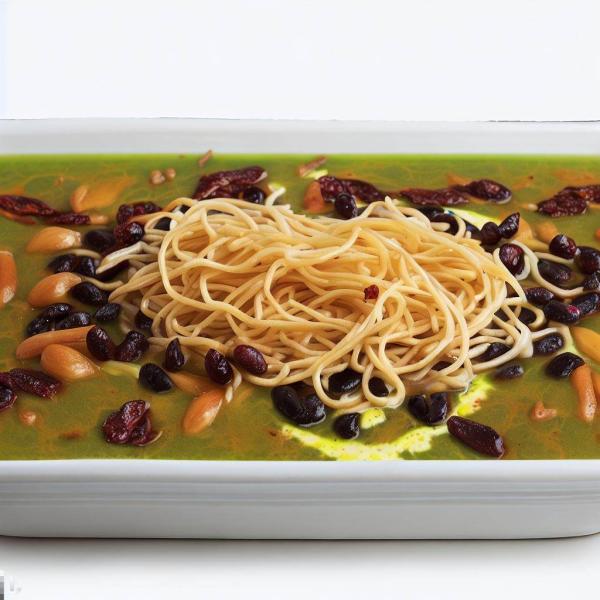
Aash Reshteh is a thick and hearty soup that is one of the most popular and comforting dishes in Iranian cuisine. The name of the dish means “noodle soup” in Persian, and it refers to the main ingredient of the soup: a type of flat and thin noodles that are made from wheat flour. The noodles are cooked with a variety of beans and lentils, such as kidney beans, chickpeas, navy beans and green or red lentils. The soup also contains a large amount of fresh herbs, such as parsley, cilantro, spinach and dill, that give it a vibrant green color and a fresh flavor. The soup is seasoned with salt, pepper, turmeric and sometimes dried mint or rose petals. The soup is usually topped with fried onions, mint, garlic and kashk (a fermented whey product) that add a crunchy and tangy contrast to the soup. Aash Reshteh is typically served with bread or lavash (a thin flatbread) and torshi (pickled vegetables). Aash Reshteh is a nutritious and filling dish that is rich in protein, fiber, iron and vitamin C. It is often prepared for special occasions, such as Nowruz (the Persian New Year), Ramadan (the Islamic month of fasting) and Mehregan (the autumn festival). Aash Reshteh is a symbol of the generosity and hospitality of Iranian culture and cuisine.
Dolma
Stuffed grape leaves filled with rice, herbs, meat and spices. They are cooked in a tangy sauce of pomegranate molasses and grape juice.
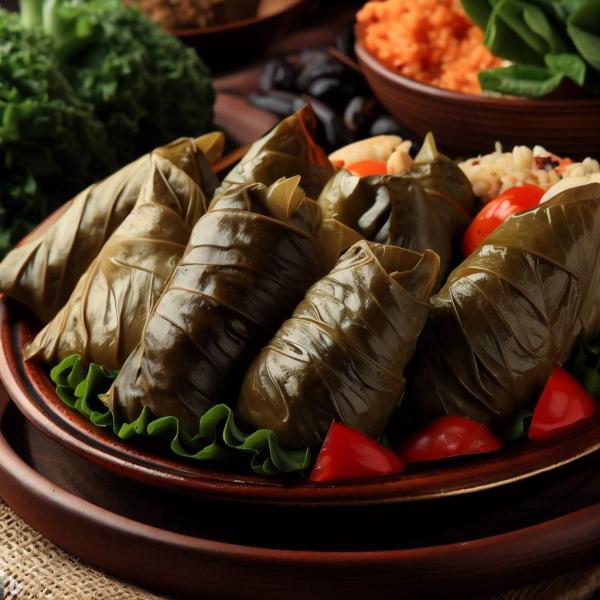
Dolma is a stuffed vegetable dish that is common in many cuisines of the Middle East, Central Asia and the Mediterranean. The word dolma comes from the Turkish word dolmak, which means “to fill”. Dolma can be made with various vegetables, such as grape leaves, cabbage leaves, peppers, tomatoes, eggplants or zucchini, that are hollowed out and filled with a mixture of rice, meat, herbs and spices. The filling can vary depending on the region and personal preference, but it usually contains minced lamb or beef, onion, garlic, parsley, dill, mint, cinnamon, allspice and salt. The stuffed vegetables are then arranged in a pot and cooked in a sauce of water, lemon juice, olive oil and sometimes tomato paste. The sauce helps to moisten and flavor the dolma and prevents them from sticking to the pot. Dolma can be served hot or cold, as a main course or an appetizer. Dolma is often accompanied by yogurt or garlic sauce and bread or rice. Dolma is a delicious and versatile dish that can be enjoyed in different seasons and occasions. Dolma is a symbol of the culinary diversity and creativity of the countries and cultures that have adopted and adapted this dish.
Fesenjan
A sweet and sour stew of chicken or duck cooked in a sauce of ground walnuts and pomegranate paste. It is usually served with rice or bread.
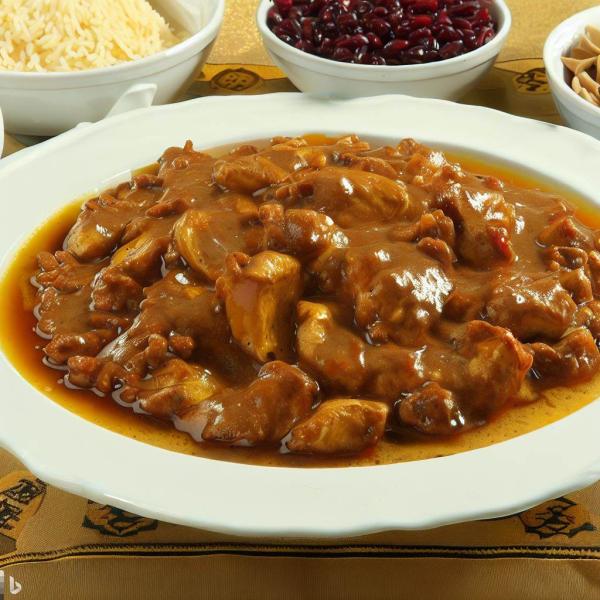
Fesenjan is a sweet and sour stew that is one of the most famous and delicious dishes in Iranian cuisine. The name of the dish comes from the Persian word fesenjān, which means “pomegranate stew”. Fesenjan is made with a sauce of ground walnuts and pomegranate paste that gives the dish its distinctive flavor and color. The sauce is cooked with chicken or duck that are cut into pieces and browned before being simmered with the sauce. The sauce can also be made with meatballs, lamb or fish instead of poultry. The stew is seasoned with salt, pepper, sugar and sometimes saffron or cinnamon. The stew is usually thick and rich, but it can be adjusted to personal taste by adding more or less water, pomegranate paste or sugar. Fesenjan is typically served with rice or bread and salad or yogurt. Fesenjan is a festive and elegant dish that is often prepared for special occasions, such as weddings, holidays and family gatherings. Fesenjan is a symbol of the culinary heritage and sophistication of Iranian cuisine and culture.
Zereshk Polo
A festive dish of rice mixed with barberries (sour red berries), saffron and butter. It is often accompanied by chicken or lamb.
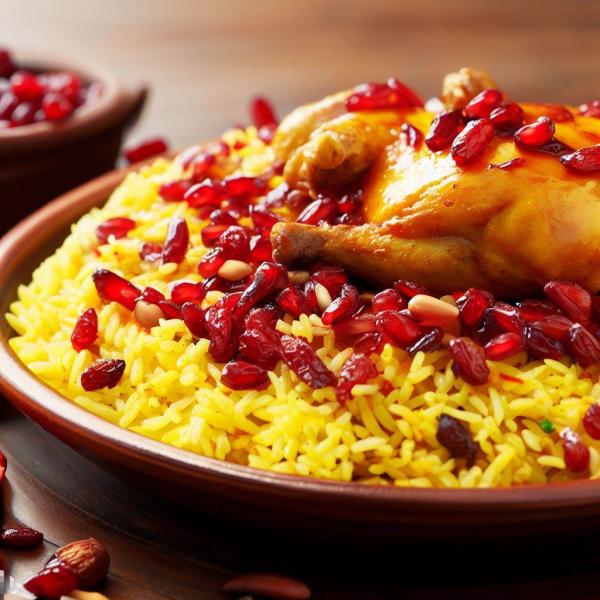
Zereshk Polo is a festive rice dish that is one of the most popular and delicious dishes in Iranian cuisine. The name of the dish means “barberry rice” in Persian, and it refers to the main ingredient of the dish: a type of sour red berries that are native to Iran and other parts of Asia. Zereshk Polo is made with rice that is cooked with butter, oil and saffron. The rice is then mixed with barberries that are soaked in water and sugar and fried in oil. The barberries add a burst of sourness and color to the rice. The rice is usually served with chicken or lamb that are cooked separately with onions, garlic, turmeric and salt. The meat can be roasted, fried or stewed with a sauce of tomato paste, lemon juice and saffron. The dish is often garnished with pistachios, almonds or slivered orange peel that add crunch and flavor. Zereshk Polo is typically served for special occasions, such as weddings, holidays and family gatherings. Zereshk Polo is a colorful and tasty dish that is rich in carbohydrates, protein and vitamin C. It is one of the most beloved dishes in Iranian cuisine and culture.
These are just some of the many delicious Iranian dishes you can enjoy. I hope you get a chance to taste them soon!
